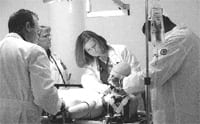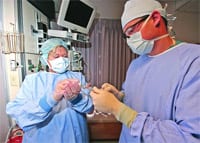Breakthrough Science Can’t Be Rushed
In an extraordinary and well-intentioned act of support for biomedical research, the economic stimulus package included more than $8 billion in new research funding for the National Institutes of Health. But there’s a catch: to create jobs as quickly as possible, the package requires that much of the money be spent and the research completed in the next two years.
This, in turn, is creating some unexpected consequences. The prospect of rapid funding is whipping researchers into a grant-writing frenzy, initially resulting in tens of thousands of grant proposals competing for several hundred awards and overwhelming the peer-review process.
In 30 years of research, I have never witnessed such a mad rush for funding.
It is a fact of academic life that many junior faculty in medical schools, schools of public health, and research institutes must obtain research funding to pay their salaries and their staff. This short-term surge in NIH stimulus funds resulted in about 20,000 applications that are now competing for approximately 300 to 400 ‘challenge’ grants of about $1 million each. This will result in an astonishingly low funding rate of about 1{06cf2b9696b159f874511d23dbc893eb1ac83014175ed30550cfff22781411e5} to 2{06cf2b9696b159f874511d23dbc893eb1ac83014175ed30550cfff22781411e5} (compared with about 20{06cf2b9696b159f874511d23dbc893eb1ac83014175ed30550cfff22781411e5} for regular NIH grants), a huge disappointment for the majority of investigators.
What’s more, the thousands of unsuccessful proposals are likely to be revised and quickly resubmitted for other NIH grants, creating a continuing bulge in unfunded applications at great cost to investigators and their administrative staff, not to mention NIH staff.
The sheer number of proposals is likely to overwhelm the NIH’s capacity to conduct adequate, high-quality reviews. Without the typical rigorous deliberation by committees of scientist/peer reviewers, there will be errors in judgment — opportunities for taxpayer dollars to fund poorly conceived, redundant research. Even more disconcerting, outstanding studies that promise important medical discoveries will go unfunded. Furthermore, with so many scientists and their colleagues submitting proposals, it will be difficult to recruit capable reviewers who do not have a conflict of interest.
From the standpoint of fixing our battered economy, this effort will be judged more by the numbers of jobs created than the significance of the resulting research findings. The recession is causing layoffs or early retirement of existing, experienced staff and faculty. It is unclear whether continued NIH funds will allow retention of these newly trained staff, or whether they will be laid off after the temporary increase in funding.
NIH generally knows what it is doing and needs Congress and the administration to fund its work, not micromanage its affairs. It has been awarding and administering grants for about 80 years. Its finely tuned process is at odds with a rigid, regulatory stimulus program that will be expensive to administer and have a very low yield for budding scientists.
There is time to adjust the legislative and administrative process in order to put the remaining billions of stimulus dollars to more productive use.
First, the administration must abandon the mandates for impractical two-year studies. Instead, it should ensure sustained increases in overall funding of NIH over the next decade by devoting a share of gross domestic product to all research and development. Second, it must allow more flexibility by NIH to decide how the $8 billion in research funds should be spent. Finally, it should encourage creativity by investigators to propose their best and most promising ideas rather than force strict compliance to narrowly defined, predetermined research priorities.
A quick shot of money may create some jobs in the next two years — but breakthrough science can’t be rushed.
Stephen B. Soumerai is a professor of ambulatory care and prevention and director of the Drug Policy Research Group at Harvard Medical School. This article first appeared in the Boston Globe.



